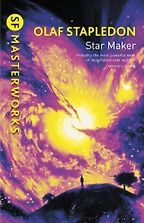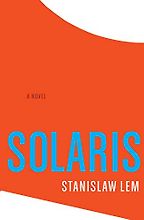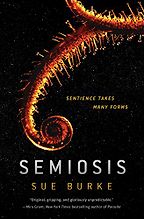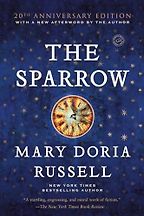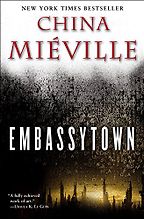Thank you for selecting these five excellent science fiction books that imagine alien life. I’d like to start by quoting a section of your book, The Possibility of Life, back to you:
…science fiction is more than entertainment, it’s a generative act that creates new possibilities of life beyond Earth, as valid and potent as anything we might conjure up in the lab.
Could you say a little more about why you see sci-fi as an intellectually significant pursuit running in parallel with science itself?
Science fiction is very much in conversation with science. Science comes up with new possibilities, new technologies—and science fiction extrapolates that out, imagines several steps ahead of scientific ideas and discoveries. But we also know that science fiction has often been the seed of scientific ideas. Rocket propulsion was first imagined in science fiction, for example, and that was what inspired the development of actual rocketry.
I think there’s also a way in which science fiction not only imagines the scientific implications and the scientific extrapolations of new technologies and new discoveries, but tests out the societal and personal meanings of scientific discoveries. What I mean by that is: we take a new scientific idea, and see through narrative how that makes us feel, and how we might integrate that into our worldview.
“Science fiction is very much in conversation with science”
This was a big thing during the Renaissance after the discoveries of Copernicus and Galileo; there were all sorts of new stories that imagined out what it meant that the Earth was just one planet among many, that there were other planets, other worlds in the solar system. Science fiction was a way of trying to make sense of that, and see how that fits into a worldview, not just with new facts but with stories and narrative and personal experiences.
That’s an interesting way of looking at it. It strikes me, looking at this list of books you’ve chosen to recommend, that many of them are taken up with questions of ethics.
Exactly, they’re also ethical thought experiments for understanding human experience and human history in different ways. By setting them in the future, or on another world, or showing humans interacting with aliens, we are able to distance ourselves from these stories, make them strange, and look at them from a new distance.
One of the books I’ve selected is Mary Doria Russell’s The Sparrow. She has explicitly said it was inspired by the 500th anniversary of Columbus coming to the Americas. It was her imagining what if. What if a similar first contact was made, even with the best of intentions? How might that still be disruptive? How might it play out? So there are ways of recasting and reframing themes from human history or interpersonal contact.
Let’s look at the books on your list, starting with Star Maker by Olaf Stapledon, a book you have described as “a vast and inspiring vision of what advanced alien life and the cosmos could be.” Can you talk us through it?
This is actually a perfect example of the relationship between science and science fiction. It’s mostly known now as the origin of the idea of Dyson spheres. So: Dyson spheres are named after Freeman Dyson, a physicist, and mathematician … a true polymath who popularised this idea that a super-advanced civilisation might power itself by building a sphere, or a spherical swarm, of satellites around a star, so as to capture the energy coming off that star. You know, here on Earth we get a tiny fraction of the sun’s energy, just whatever hits the Earth. A really advanced civilisation would want to capture more of that free energy. He always credited this idea as coming from this science fiction novel Star Maker.
So I originally decided to read Star Maker because I know of it as the source of Dyson spheres. And I was really expecting a book about Dyson spheres—a civilisation powering itself that way, or maybe an ancient artifact from a long-gone civilisation. There’s actually an episode of Star Trek: Next Generation where a relic Dyson sphere is found. But I was blown away to find that, in Star Maker, Dyson spheres are mentioned in about half a sentence. You really have to be looking for it.
It’s not a book about a single advanced alien society, or really about technology. It’s this fantastically sweeping imagining of all the different ways that intelligent life might evolve on planets, that civilisations might seek advancement.rd
Get the weekly Five Books newsletter
The book was published in 1937. Stapledon was an English author. Star Maker was explicitly a response to the rise of fascism. He talks in the book about how civilisations, planetary cultures, face this hurdle that they all come up against in their development. It’s fascism, which—as he sees it—is not just a governmental control but the opposition to openness and connection. So this vast and sort of mystical imagining of different versions of life and culture is really about imagining how some civilisations find their way through the darkness.
But it’s also about, you know, planets and galaxies and stars. It’s a book that surprised me so much. It’s a beautiful, strange book that I really fell in love with. It was probably the most wonderful surprise of my research.
I love that. When people are discussing science fiction, they often make a distinction between ‘hard’ science fiction and ‘soft’ science fiction. How would this be categorised?
I don’t think Star Maker counts as hard science fiction, because the technology is all kind of hand-wavy. You know? So it falls somewhere in the middle. There’s also telepathy—the civilisations that reach levels of enlightenment that humanity hasn’t attained yet have a kind of global consciousness that they achieve, not through the flattening homogeneity of fascism, but in a kind of unity where individuals retain their own purpose and passions, but share a collective consciousness through telepathy.
I do love some hard sci-fi. I write about Vernor Vinge in the book, and I also really love Neal Stephenson. But I only love it when it is also character-driven. Technology is cool and fun, but I think I’m drawn to humanistic stories. You know? I love Ursula le Guin, and she is very much an anthropologist’s daughter. She’s interested in societies and people and interactions, and how we figure out how to be in the world—whether that be as aliens or humans.
Let’s move on to your second science fiction book recommendation, which offers an encounter with an alien of almost incomprehensible form. This is Stanislaw Lem’s Solaris.
Yes. This is my favourite example of a truly alien alien. In the book, they are not even sure if it is self-aware or intelligent. Basically, humans have discovered an alien planet called Solaris. Its surface is covered by an ocean. But over the course of the book, you realise that this is not a body of water. It is a planet-spanning liquid body of some kind, but it seems to be an alien entity as well. It creates strange shapes and constructions out of its own matter that seem like manifestations of complex math. They can’t tell if these are weird reflexes, thoughts, dreams, or attempts at communication. When human astronauts go to the shore of the ocean, it seems to reach for them physically. It reminds me of that scene in Moana where she meets the sea, and it reaches out and drops a shell in her hand. It’s a lot like that.
The book opens after the crew of a space station on the planet has bombarded the ocean with some kind of radiation to try to get it to react. It has responded by creating physical manifestations of human beings out of the memories of the human crew of the station. Every crew member meets this weird, ghostly presence of someone they know. These are not ghosts, but physical bodies. The main character is visited by his long-dead wife, who has been crafted out of his memories. She doesn’t know anything that he doesn’t know. But she seems to think that she is a person and that she is there. It’s tremendously weird and spooky.
I really love this book. It’s short, it’s really quite mind-blowing, and it unfolds like a horror movie.
Yes. And, you know, it’s very much a mid-century sci-fi book. The way the technology is imagined is really funny to me. Like, they have faster-than-light travel, but also a physical library. There’s a whole academic field of studying this opaque, alien entity where they sit and read books and look at microfiche. So much of the plot or the conflict of the book wouldn’t happen if they had security cameras and could see what was really happening. But without that, it’s all a mystery: who is real, and where do they go?
It’s also a very mid-century sci-fi book in that it feels like a very male point of view. The main character is a man visited by his beautiful 19-year-old wife who only exists as a manifestation of his thoughts and ideas. I was not won over by that. But it is still a really fascinating imagining of how humanity would confront the impossibility of understanding a truly alien alien.
Right. I was pleased to see that your book was endorsed by Ed Yong, the author of An Immense World: How Animal Senses Reveal the Hidden Realms Around Us. Because that book was mind-blowing in a similar way, in forcing us to try to imagine how it feels to live as other species. It made me think about how impossible it might be to ever communicate with aliens, given how truly alien some of our fellow Earth-dwellers’ inner worlds already must be.
I don’t think that Solaris was meant to be a metaphor for trying to communicate with other life on Earth. But I do think that our attempts to understand and imagine our way into the experience of other life on Earth does tell us a lot about what alien contact might be like. Examples that I write about in my book include dolphins and bats, which—interestingly—we are closely related to, relatively speaking, but live in different environments. They both live in three dimensional environments: dolphins swim underwater, bats fly. They both used different senses—echolocation and sonar—to engage with their environments. So it makes sense that their worldview, their experience of the world, their communication methods would be very different from ours.
Whereas if we met an alien that also lived on land and breathed the air and manipulated objects with their hands, it’s maybe more likely that they would share the same sense as us. And, as Ed points out in his book, therefore have a similar experience of the world and the way they move through it.
Maybe this brings us to Sue Burke’s Semiosis, which is a multi-generational saga about settlers in a new space colony—with a bit of a twist. What does this sci-fi book tell us about alien life?
In some ways this is a classic ‘first contact’ novel. Human colonists have come to an alien planet, they discover an intelligent alien, and they try to get to know it. The twist here is that the alien is a sentient plant.
That almost sounds like a gimmick, but the book is so robustly researched and imagined, and Burke works really hard to figure out how a plant might develop intelligence—working from the starting point that plants on Earth already have a lot of intelligence. They sense their environments, transmit information… They are not inert. She’s just extrapolating from what we know. The idea is that the planet in Semiosis is a billion years older than Earth. So all of life has had a billion more years to evolve.
“Our attempts to understand and imagine our way into the experience of other life on Earth does tell us a lot about what alien contact might be like”
The alien is called Stevland. The human colonists named it after the first colonist that died—their idea had been that they would name the most important life form that they found on the planet after that first death. And Stevland the plant ends up being incredibly important to them.
Stevland is functionally immortal; he could be killed, but he doesn’t die or age, he doesn’t exist in generations. He clones himself and spreads. Every human baby is born at the same starting point, setting each generation back to the same place. But Stevland just learns and grows. He’s extremely alien—he has a different worldview, a very different experience of life. But he’s much more familiar than the ocean in Solaris, or even the aliens in Arrival. Early on in the book there’s section from his point-of-view. So he has an ‘I’. You’re able to experience how he experiences things differently—what it feels like to be a plant, but from that familiar first-person perspective.
As you’ve mentioned it, can we touch on the film, Arrival, and the Ted Chiang short story, ‘Story of Your Life’, that it’s based on? It’s very short, but has remarkable depth.
When I interviewed scientists for my book, I often tacked on a question about their favourite sci-fi alien, and Arrival and ‘Story of Your Life’ were the most often mentioned, because they are really alien-seeming aliens. Especially in the short story. In the movie, we find out why the aliens have come. In the short story we don’t: they’re there for a while, the main character learns there language, and then one day they leave and we never know why. There’s a lot more mystery.
I interviewed Chiang and asked him about writing these very alien aliens. I asked if they had interiority to him—if he knew about their motivations. He said, no, absolutely not. In order to write alien aliens, they had to be opaque to him too. I thought that was really interesting. It was almost strategic—he had to keep them alien to himself, so that they might be alien to the reader as well.
That’s fascinating. Let’s come back to Mary Doria Russell’s The Sparrow, which you mentioned earlier. It won a host of awards when it was first published in 1996, but I have to admit it was new to me. Can you tell us about it?
Sure. This is similar to Semiosis, in that it has an easy hook, which is: Jesuits in space.
Ha!
It’s set in the relatively near future, the early 21st century. We’ve caught up to it in time now. The idea was that we overhear a signal from another planet—not directed at us, music. It happens to be coming from the nearest star to us, Alpha Centauri, which is only four light years away. And while the governments of the world are figuring out what to do, the Jesuits—who have always, as Russell writes, “sought to know God’s other children”—pull together a mission and go.
I think that’s so smart. I can see that: missionaries function outside of governmental red tape, and would just get it together and go because that’s what they’ve been doing for centuries. As I said, it was inspired by the 500th anniversary of Columbus. Russell sees this crew going with the best of intentions, with nothing but openness. They’re not trying to proselytise, they’re trying to know God’s other creatures.
“Science fiction is about trying to stretch your imagination to see if you can hold an impossible idea in your head, just for a moment”
Before she became a novelist, Russell was a paleo-anthropologist. She studied Neanderthals. And the Neanderthals are an example of another sentient species that humans once knew and interacted with. Sure enough, there are two sentient species on the planet that the humans in The Sparrow go to. The humans are kind of slow to figure this out, and are slow to figure out the complex societal relationships between these two species. It’s a fantastically beautiful book; the world is imagined so vividly. And it’s a real, real gut punch of a book. But while there is tragedy, it’s really about trying to know who else might be out there, and connect with them.
The main character in The Sparrow is a Jesuit priest who is also a field linguist. He’s the one who is able to figure out how to bridge communication between humans and the aliens they meet.
Your description reminds me a little of Michel Faber’s beautiful novel The Book of Strange New Things, which also follows a Christian missionary embedded in an alien settlement. But let’s stay on track and talk about your final book recommendation, China Mieville’s Embassytown—another science fiction book about the difficulties of communication between humans and aliens.
Yes, Embassytown is also centred around the idea of alien languages. It’s another example of the more incomprehensible alien species—it’s set on a planet where the native aliens speak two words at the same time. Basically they have two vocal organs, so their language consists of two tracks where we have only one. The human explorers who first met them had translation software and two speakers, and made two sounds at the same time, but these aliens did seem to recognise it even as an attempt at speech.
It’s only when—and this is the backstory to the novel—a couple of frustrated human linguists each shout half of the greeting word that these aliens even realise they are being spoken to. That’s because, in this story, the alien language doesn’t function representationally but rather as a direct conduit to the mind.
Five Books interviews are expensive to produce. If you're enjoying this interview, please support us by donating a small amount.
This is somewhat fantastical, and it gets tied up with the limits of this alien language. They can’t say anything untrue, for example, because their language is not a symbol. They have this fantastically weird setup where they are able to speak in similes, but the simile must be drawn from something real. The main character, as a girl, was recruited to enact a simile—so they can say something is “like the girl who ate what was given to her”… It adds all these layers of meaning that are hard for me, as a human, to wrap my head around. A lot of the plot of the book hinges on the way that the aliens experience language, and experience the world as a result.
That’s an interesting point—that these books deal in ideas that are hard for us, as humans, to comprehend. That feels to me like a crucial element of what science fiction is: it is interrogating what apparently indisputable truths of our existence are, in fact, merely constructs of the human mind.
It’s also about trying to stretch your imagination to see if you can hold an impossible idea in your head, just for a moment. It’s like trying to imagine what it means that the universe is expanding in more dimensions than we can see. It’s like trying to imagine what a tesseract looks like—a cube squared again. Like, we can’t. But if you really, really try, you can get kind of close. Or you can get it for a second.
I think a lot of the pleasure of science fiction comes from encountering new and impossible ideas, and viewing them in a world and in a story that is believable. It stretches you not only to imagine different kinds of people’s experiences, but different realities as well.
Interview by Cal Flyn, Deputy Editor
May 9, 2023. Updated: January 10, 2025
Five Books aims to keep its book recommendations and interviews up to date. If you are the interviewee and would like to update your choice of books (or even just what you say about them) please email us at [email protected]


